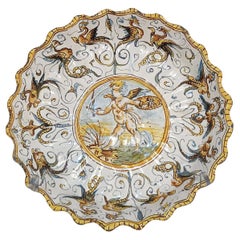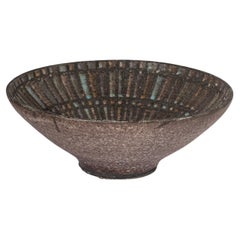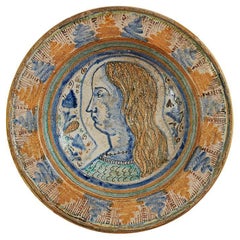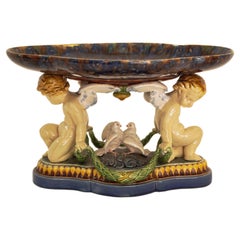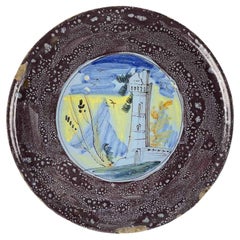Maiolica Bowls and Baskets
15
1
to
3
13
2
16
15
15
4
2
1
1
1
1
10
3
2
1
2
1
1
Height
to
Width
to
124
5,383
4,290
3,635
2,209
16
11
1
1
1
2
1
1
1
1
Material: Maiolica
SECOND HALF OF THE 16th CENTURY POLYCHROME MAIOLICA PLATE
Located in Firenze, FI
Splendid plate in polychrome glazed majolica in yellow, blue, green and manganese. The plate has a wavy rim which gives it the name "crespina", and in the center it is adorned with t...
Category
16th Century Italian Renaissance Antique Maiolica Bowls and Baskets
Materials
Maiolica
Large bowl, Aldo Londi for Bitossi, 1950s
By Aldo Londi, Bitossi
Located in Firenze, IT
Beautiful, large bowl designed by Aldo Londi for Bitossi, for which he was art director, in the early 1950s. It is molded with refractory earth in shades of brown with a rather rare ...
Category
1950s Italian Mid-Century Modern Vintage Maiolica Bowls and Baskets
Materials
Ceramic, Maiolica
16th Century Italian Maiolica Faience Dish with a Young Man Portrait
Located in Milan, IT
Mid-16th Century Italian Maiolica Dish hand-painted in blue and ocher yellow color with a profile young man portrait in the center. The maiolica col...
Category
16th Century Italian Renaissance Antique Maiolica Bowls and Baskets
Materials
Maiolica
Antique 19th Century Minton Majolica Centerpiece Tazza with Doves & Cherubs 1861
By Minton
Located in Portland, OR
A good antique Minton Majolica centerpiece/tazza, 1861.
The centerpiece with a flanged shaped shallow dish supported with a pair of winged cher...
Category
1860s English Victorian Antique Maiolica Bowls and Baskets
Materials
Maiolica
18th Century Italian Berrettino Majolica Faience Riser
Located in Milan, IT
An Italian maiolica berrettino-ground riser from 18th century, central Italy, probably Faenza origin. In the central part of the riser a ruined tower is painted within a mountain lan...
Category
Mid-18th Century Italian Rococo Antique Maiolica Bowls and Baskets
Materials
Maiolica
Large Antique Italian 18th Century Maiolica Faience Istoriato Plate Urbino 1790
By Urbino Workshop
Located in Portland, OR
A large & fine antique Italian maiolica Istoriato charger, Urbino, circa 1800.
This very handsome charger is hand-painted with Neoclassical nu...
Category
Late 18th Century Italian Baroque Antique Maiolica Bowls and Baskets
Materials
Maiolica
Lorenzo Rubboli Two Handled Lustre Bowl
Located in East Geelong, VIC
This two handled, footed bowl with a lustre glaze is by Lorenzo Rubboli of Gualdo Tadino in Umbria, Italy. The centre of the bowl is decorated with a stylised flower which is contain...
Category
1930s European Renaissance Revival Vintage Maiolica Bowls and Baskets
Materials
Maiolica
Apollineo Arena Centerpiece in Leccese Stone and Hand-Painted Maiolica
By TIPSTUDIO
Located in Florence, IT
The Apollineo collection mergs classical and contemporary elements to define a unique aesthetic inspired by Mediterranean architecture and vibes. Sun-blessed pure volumes, shapes mar...
Category
2010s Italian Modern Maiolica Bowls and Baskets
Materials
Stone, Limestone
Italian Maiolica Ancient Sugar Bowl, Lodi, 1770-1780
Located in Milano, IT
Maiolica sugar bowl
Antonio Ferretti Manufacture
Lodi, Circa 1770-1780
Maiolica polychrome decorated “a piccolo fuoco” (third fire).
It measures 3.54 x 4.52 x 3.54 in (9 x 11,5 x 9 cm)
Weight: 0.394 lb (0.179 kg)
State of conservation: small and slight chips on the edges.
The small sugar bowl has a swollen and ribbed body resting on a flat base. The cap-shaped lid follows the rib of the container and is topped with a small knob in the shape of a two-colored fruit.
The sugar bowl is painted “a piccolo fuoco” (third fire) with the characteristic floral motif of bunches and isolated semis.
An example which closely corresponds to this one is kept at the Civic Museum in Lodi (G. Gregorietti, Maioliche di Lodi, Milano e Pavia, Catalogo della Mostra, Milano, 1964 n. 137).
This decorative style represented a strong point of the Lodi factory, which established itself thanks to the vivid nature of the colors made possible by the introduction of a new technique perfected by Paul Hannong in Strasbourg and later introduced by Antonio Ferretti to Italy. The production process, called “piccolo fuoco” (third fire), allowed the use of a greater number of colors than in the past; in particular, the purple of Cassius, a red made from gold chloride, was introduced. Its use allowed for many more tones and shades, from pink to purple.
The Ferretti family started their maiolica manufacturing business in Lodi in 1725.
The forefather Simpliciano started the business by purchasing an ancient furnace in 1725 and, indeed, we have evidence of the full activity of the furnaces starting from April of the same year (Novasconi-Ferrari-Corvi, 1964, p. 26 n. 4). Simpliciano started a production of excellence also thanks to the ownership of clay quarries in Stradella, not far from Pavia. The production was so successful that in 1726 a decree of the Turin Chamber came to prohibit the importation of foreign ceramics, especially from Lodi, to protect internal production (G. Lise, La ceramica a Lodi, Lodi 1981, p. 59).
In its initial stages, the manufacture produced maolicas painted with the “a gran fuoco” (double fire) technique, often in turquoise monochrome, with ornamentation derived from compositional modules in vogue in Rouen in France. This was also thanks to the collaboration of painters like Giorgio Giacinto Rossetti, who placed his name on the best specimens next to the initials of the factory.
In 1748 Simpliciano made his will (Gelmini, 1995, p. 30) appointing his son Giuseppe Antonio (known as Antonio) as universal heir. After 1750, when Simpliciano passed away, Antonio was directly involved in the maiolica factory, increasing its fortunes and achieving a reputation on a European level. Particularly important was the aforementioned introduction in 1760 of the innovative “a piccolo fuoco” (third fire) processing, which, expanding the ornamental repertoire with Saxon-inspired floral themes, was able to commercially compete with the German porcelains that had one of its most renowned offerings in the naturalistic Deutsche Blumen. Antonio Ferretti understood and promoted this technique and this decoration, proposing it in a fresher and more corrective version, less linked to botanical tables, both with or without contour lines, as well as in purple or green monochrome. After efforts to introduce more industrial production techniques to the sector succeeded, even the Ferretti manufacture, in the last decade of the eighteenth century, started heading towards decline despite its attempts to adapt production to neoclassical tastes.
In 1796 the Napoleonic battle for the conquest of the Lodi bridge over the Adda definitively compromised the furnaces. Production resumed, albeit in a rather stunted manner, until Antonio's death on 29 December 1810. (M. L. Gelmini, pp. 28-30, 38, 43 sgg., 130-136 (for Simpliciano); pp. 31 sgg., 45-47, 142-192 (for Antonio).
Bibliography
G. Gregorietti, Maioliche di Lodi Milano e Pavia Catalogo della Mostra, Milano, 1964 n. 137;
C. Baroni, Storia delle ceramiche nel Lodigiano, in Archivio storico per la città e i comuni del circondario e della diocesi di Lodi, XXXIV (1915), pp. 118, 124, 142; XXXV (1916), pp. 5-8;
C. Baroni, La maiolica antica di Lodi, in Archivio storico lombardo, LVIII (1931), pp. 453-455;
L. Ciboldi, La maiolica lodigiana, in Archivio storico lodigiano, LXXX (1953), pp. 25 sgg.;
S. Levy, Maioliche settecentesche lombarde e venete, Milano 1962, pp. 17 sgg.;
A. Novasconi - S. Ferrari - S. Corvi, La ceramica lodigiana, Lodi 1964, ad Indicem; Maioliche di Lodi, Milano e Pavia (catal.), Milano 1964, p. 17;
O. Ferrari - G. Scavizzi, Maioliche italiane del Seicento e del Settecento, Milano 1965, pp. 26 sgg.;
G. C. Sciolla, Lodi. Museo civico, Bologna 1977, pp. 69-85 passim; G. Lise, La ceramica a Lodi, Lodi 1981;
M. Vitali, in Storia dell'arte ceramica...
Category
1770s Italian Rococo Antique Maiolica Bowls and Baskets
Materials
Maiolica
Antique French Faience Lidded Bowl Tureen Hand Painted with Flowers and Insects
By Rouen
Located in Firenze, IT
A French 18th century large polychrome Faience lidded soup toureen or entree dish with scallop-shaped edges attributable to Rouen manufacture.
This lovely...
Category
18th Century French Rococo Antique Maiolica Bowls and Baskets
Materials
Maiolica, Faience, Pottery, Porcelain
Spanish 17th Century Ceramic Circular Charger Plate, Talavera or Puente
Located in Barcelona, ES
Spanish Faience charger with floral motifs. Talavera de la Reina-Puente del Arzobispo, Toledo. Spain, late 17th century.
Hand painted in ochre, yellow, brown and blue with a central...
Category
Late 17th Century Spanish Antique Maiolica Bowls and Baskets
Materials
Ceramic, Earthenware, Faience, Maiolica
18th Century Italian Majolica Faience Centerpiece Large Lodi Circular Bowl
Located in Milan, IT
18th century Italian collectible antique painted majolica bowl, a large basin-shaped centerpiece, with vertical ribs, decorated with polychrome flowers. Small chips, felure and minor...
Category
Mid-18th Century Italian Rococo Antique Maiolica Bowls and Baskets
Materials
Maiolica
Two Pairs of Italian Maiolica Baskets, circa 1780
Located in Milano, IT
Two pairs of maiolica baskets
Antonio Ferretti Manufacture
Lodi, circa 1770-1790
Maiolica polychrome decorated “a piccolo fuoco” (third fire).
Measures: A) Height 3.54 x 6.69 x 9.84 in (9 x 17 x 25 cm);
B) Height 3.93 x 7.48 x 11.02 in (10 x 19 x 28 cm).
Total weight 4.85 lb (2.200 kg)
State of conservation:
A) One of the smaller baskets has some areas of restoration, the other slight chipping from use;
B) One of the larger baskets is intact and the other shows a clearly glued break.
The mold with which the baskets were forged simulates a wicker weave.
The two larger works have high, vertical walls, with branch-shaped handles penetrating the weave. The painted decorations, small polychrome flowers applied only externally, highlight the points where the weaves intersect.
The decision to leave the center of the basket devoid of decoration is highly unusual, but given the size and complexity of the shape, as well as the quality of the enamel, it is possible to hypothesize that it represents a precise choice in manufacturing or for a particular client.
The two smaller baskets have small, twisted handles and, on the outside, reproduce more decisively the characteristic wicker weave, obtained through thin molded lines. The interior exhibits a rich, typical decoration of naturalistic flowers: a bunch centered around a main flower and secondary stems accompanied by small “semis”. The exterior of these works is also adorned with small little flowers where the weaves intersect.
The size and morphological characteristics of the baskets confirm their attribution to the Lodi factory of Antonio Ferretti between 1770 and 1790, during its most successful period; by this point his original reworking of the "Strasbourg" decoration, known as "old Lodi", had achieved great fame even outside Italy.
This decorative choice represented a strong point of the Lodi factory, which established itself thanks to the vivid nature of the colors made possible by the introduction of a new technique perfected by Paul Hannong in Strasbourg and which Antonio Ferretti introduced in Italy. This production process, called “piccolo fuoco” (third fire), allowed the use of a greater number of colors than in the past; in particular, the purple of Cassius, a red made from gold chloride, was introduced. Its use allowed for many more tones and shades, from pink to purple.
The Ferretti family had started their maiolica manufacturing business in Lodi in 1725.
The forefather Simpliciano had started the business by purchasing an ancient furnace in 1725 and, indeed, we have evidence of the full activity of the furnaces from April of the same year (Novasconi-Ferrari-Corvi, 1964, p. 26 n. 4). Simpliciano had started a production of excellence also thanks to the ownership of clay quarries in Stradella, not far from Pavia. The production was so successful that in 1726 a decree of the Turin Chamber came to prohibit the importation of foreign ceramics, especially from Lodi, to protect internal production (G. Lise, La ceramica a Lodi, Lodi 1981, p. 59).
In its initial stages, the manufacture produced maolicas painted with the “a gran fuoco” (double fire) technique, often in turquoise monochrome, with ornamentation derived from compositional modules in vogue in Rouen in France. This was also thanks to the collaboration of painters like Giorgio Giacinto Rossetti, who placed his name on the best specimens next to the initials of the factory.
In 1748 Simpliciano made his will (Gelmini, 1995, p. 30) appointing his son Giuseppe Antonio (known as Antonio) as universal heir. After 1750, when Simpliciano passed away, Antonio was directly involved in the maiolica factory, increasing its fortunes and achieving a reputation on a European level. Particularly important was the aforementioned introduction in 1760 of the innovative “a piccolo fuoco” (third fire) processing, which, expanding the ornamental repertoire with Saxon-inspired floral themes, could commercially compete with the German porcelains that had one of its most renowned offerings in the naturalistic Deutsche Blumen. Antonio Ferretti understood and promoted this technique and this decoration, proposing it in a fresher and more corrective version, less linked to botanical tables...
Category
1770s Italian Neoclassical Antique Maiolica Bowls and Baskets
Materials
Maiolica
Lodi Faience Plate, circa 1770
Located in Firenze, IT
SHIPPING POLICY:
No additional costs will be added to this order.
Shipping costs will be totally covered by the seller (customs duties included).
Painted with a bird perched on flo...
Category
Late 18th Century Italian Neoclassical Antique Maiolica Bowls and Baskets
Materials
Maiolica
Antique Continental Maiolica Moulded Lustre Figural Wall Plaque / Dish
Located in Bishop's Stortford, Hertfordshire
A superb antique relief moulded Continental Maiolica dish or plaque relief moulded with a side profile portrait of a figure wearing a military helmet and with the words DUX D'URBINUS...
Category
19th Century European Antique Maiolica Bowls and Baskets
Materials
Maiolica, Earthenware
Torquato Castellani Majolica Renaissance Revival Tin-Glazed Charger
Located in Bishop's Stortford, Hertfordshire
An exceptional Renaissance Revival Maiolica tin-glazed plate painted with a side profile portrait of a lady within a decorative border with a line painted design to the base. The lig...
Category
1880s Italian Renaissance Revival Antique Maiolica Bowls and Baskets
Materials
Maiolica, Earthenware
Related Items
Aldo Londi for Bitossi Rimini Blu Leaf Shaped Glazed Ceramic Bowl / Ashtray
By Aldo Londi, Bitossi
Located in Barcelona, ES
Unusual leaf design midcentury blue glazed (Rimini Blu) ceramic bowl / vide-poche / ashtray. Italy, 1950-1960s.
Designed by Aldo Londi and manufactured by Bitossi. Handcrafted in It...
Category
Mid-20th Century Italian Mid-Century Modern Maiolica Bowls and Baskets
Materials
Ceramic, Pottery, Terracotta
H 2.56 in W 7.68 in D 5.91 in
Antique Minton Staffordshire Porcelain Candelabra Centerpiece Cherub 19th Ct
By Minton
Located in Dublin, Ireland
Stunning Example of a single English Minton Porcelain Two Branch Candelabra, modelled as a Cherub holding on each hand an out swept candle holder, seated on an oval base above an ela...
Category
19th Century English Victorian Antique Maiolica Bowls and Baskets
Materials
Porcelain, Pottery
H 11.42 in W 5.32 in D 4.04 in
Aldo Londi Bitossi Rimini Blu Ceramic Round Bowl, 1950s
By Bitossi, Aldo Londi
Located in Barcelona, ES
Rimini Blue Bitossi Aldo Londi Bowl, Glazed Ceramic
Italian midcentury Aldo Londi Bitossi Rimini blue glazed ceramic circular bowl. Italy, 1950-1960s.
Beautiful blue glazed (Rimini B...
Category
Mid-20th Century Italian Mid-Century Modern Maiolica Bowls and Baskets
Materials
Ceramic, Pottery, Terracotta
Minton Majolica Lily Basket
By Minton
Located in Chelmsford, Essex
Minton Majolica basket which features pond lily leaves and flowers tied together with lily stems which form the handle. Four flower bud feet. Co...
Category
1870s English Victorian Antique Maiolica Bowls and Baskets
Materials
Majolica
Aldo Londi for Bitossi Rimini Blu Large Ceramic Horse
By Aldo Londi, Bitossi
Located in Miami, FL
Tall Italian handmade ceramic horse sculpture in the vibrant signature blue of Aldo Londi's iconic art pottery collection Rimini Blu, originally designed in 1959 for Bitossi Ceramich...
Category
20th Century Italian Mid-Century Modern Maiolica Bowls and Baskets
Materials
Ceramic
Minton Majolica Putti Figural Bowl
By Minton
Located in Chelmsford, Essex
Minton Majolica figural bowl which features putti holding leafy garlands, supporting the bowl. Colouration: cobalt blue, green, cream, are predominant. The piece bears maker's marks ...
Category
19th Century British Victorian Antique Maiolica Bowls and Baskets
Materials
Earthenware
Marble Mortar from 18th Century
Located in Marcq-en-Barœul, Hauts-de-France
Marble Mortar. French. 18th Century.
Category
1780s French Louis XVI Antique Maiolica Bowls and Baskets
Materials
Marble
Large 19th Century Italian Majolica Cantagalli Platter
By Cantagalli
Located in Haddonfield, NJ
Italian Cantagalli Faience Polychrome Serving Platter, 19th century
As found Italian Serving platter from Cantagalli. Wonderful example of antiqu...
Category
Late 19th Century Italian Renaissance Antique Maiolica Bowls and Baskets
Materials
Majolica, Pottery, Faience, Ceramic
Faience Dish - Stig Lindberg - Gustavsberg Studio - Mid 20th Century
Located in Stockholm, SE
A large dish in faience designed by Stig Lindberg at Gustavsberg Studio, it´s 30 x 19,5 cm (12" x 7.8"). It´s in excellent condition except from a minor un-glazed spot from the produ...
Category
Mid-19th Century Swedish Scandinavian Modern Antique Maiolica Bowls and Baskets
Materials
Faience
Antique Japanese Arita Plate Sometsuke Japan, 18th/19th Century
Located in Amsterdam, Noord Holland
Antique Japanese Arita Plate Sometsuke Japan, 18th/19th Century
Lovely piece, after Kangxi example.
Additional information:
Material: Porcelai...
Category
17th Century Japanese Antique Maiolica Bowls and Baskets
Materials
Porcelain
Aldo Londi for Bitossi Large Vase
By Bitossi, Aldo Londi
Located in St.Petersburg, FL
Stunning large vase designed by Aldo Londi for Bitossi, features a seta design in rare "Lobster" colors.
Measures: 16” tall
5” wide.
Category
1960s Italian Mid-Century Modern Vintage Maiolica Bowls and Baskets
Materials
Ceramic
18th Century French Marble Mortar
Located in Chicago, IL
A stunning 18th century French marble mortar with the best worn surface we've seen in years, with a tiger maple pestle. The perfect accessory for your kitchen. Fill with fruits and v...
Category
18th Century French Primitive Antique Maiolica Bowls and Baskets
Materials
Marble
Previously Available Items
Pair of Large Italian Maiolica Chargers, Venus and Neptune, 19th Century
Located in London, GB
On offer is a wonderful pair of huge Italian maiolica chargers made in the 19th Century. The chargers are painted with lively scenes of Neptune and Venus in carriages drawn by horses...
Category
19th Century Italian Renaissance Revival Antique Maiolica Bowls and Baskets
Materials
Maiolica
Set of 12 Decorative Green Midcentury Ceramic Handmade Plates
Located in Queretaro, Queretaro
This Majolica pottery plate collection was designed by Mexican sculptor, painter, and ceramist Lorenzo Lorenzzo made in his studio, in the colon...
Category
21st Century and Contemporary Mexican Mid-Century Modern Maiolica Bowls and Baskets
Materials
Ceramic, Clay, Maiolica, Majolica
Recently Viewed
View AllMore Ways To Browse
Geode Bowl
Handcrafted Wood Bowl
Copper Candy
Star Design Basket
Swedish Wooden Bowl
Antique Wooden Kitchen Signs
Ashtray Glass Shell Bowl
Murano Glass Centre Piece
Swedish Wooden Bowls
Stone Baskets Of Fruit
Minimal Modern Bowls
Gold Leaves Bowls
Iridescent Art Glass Bowl
Aqua Bowl
Round Chinese Bowls
Vintage Iridescent Glass Bowl
Green Glass Catchall
Wooden Bucket Antique
